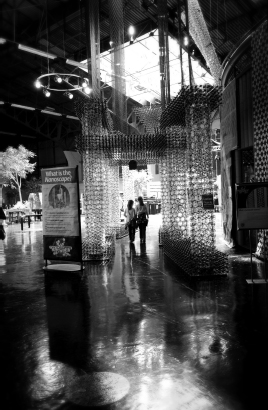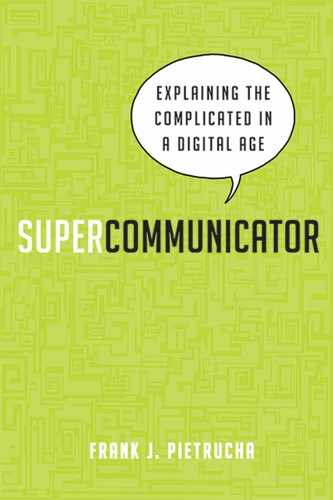Let Your Audience Explore
“Complex things happening at all levels we can't see,” explains Jennifer Frazier, of San Francisco's Exploratorium. The cell biologist, who lists “plankton” and “visualization” as her latest obsessions,14 says the reality of a lot of complex science topics is that they occur at scales we can't comprehend. “Whether its nanotechnology at a smaller scale or environmental science at a larger scale, these scales are not familiar to the general public. You can't see the whole ocean at once. Beyond our scale of perception you need visualization.”
San Francisco's Exploratorium is “a museum of science, art and human perception”15 designed to awaken visitors’ curiosity. Tools and experiences, like explore-for-yourself exhibits, try to make learning, and understanding, playful and fun. Science centers are seen as a new way to explain complicated subjects. They are set up much like a laboratory, and museum visitors are encouraged to interact with hands-on exhibits for a learning experience that's intended to be visually engaging and tactile. “These are places where people can regain their confidence in science after they've finished school,” observes the Exploratorium's executive director, Dennis Bartels. “They can come here to comprehend the world and ask questions of it. That's becoming harder and harder to do these days when you read about complicated things like the Higgs boson in the newspapers.”
Visualizations help us see a broad range of topics like evolution, genomics, climate change, ocean currents, biotech, and material science in a new light. The Nanoscale Informal Science Education (NISE) Network created a “Viz Lab” at the Exploratorium in 2005 thanks to a grant from the National Science Foundation.16 Its goal: to create a learning experience for people to experience what the nanoscale means in a way they can understand (see Figure 30.1).
Exploratorium visitors and people at other museums, libraries, and even university research centers experienced the subject of nanotechnology in a way that a textbook or a lecture couldn't. Walk into the exhibit and see illustrations, “zooms,” diagrams, and physical models that make the hard-to-imagine world of nanotechnology came to life. A variety of different visualization tools were used to make the difficult subject accessible at a more human scale:
![]() ILLUSTRATIONS. A series of illustrations showed familiar objects “across ten orders of magnitude.” See the human blood stream, a butterfly wing, or a computer chip up close…real close. Make connections between objects from vast size scales.17
ILLUSTRATIONS. A series of illustrations showed familiar objects “across ten orders of magnitude.” See the human blood stream, a butterfly wing, or a computer chip up close…real close. Make connections between objects from vast size scales.17
![]() ZOOMS. Let the audience see an object at a different scale. Zooms helped visitors go from what they saw in real life to a level where an object is beyond perception. They got a sense of relative size and understood that things are composed of smaller parts.18
ZOOMS. Let the audience see an object at a different scale. Zooms helped visitors go from what they saw in real life to a level where an object is beyond perception. They got a sense of relative size and understood that things are composed of smaller parts.18
![]() DIAGRAMS. Diagrams showed how objects were related by size, so museum-goers were able to quickly convey the size of the nanoscale.19
DIAGRAMS. Diagrams showed how objects were related by size, so museum-goers were able to quickly convey the size of the nanoscale.19
![]() SIMULATIONS. Visitors were provided with access to systems, objects, or phenomena that can't be manipulated, such as hurricanes, traffic patterns, and atomic behavior. They helped learners not just comprehend the object being studied, but its behavior.
SIMULATIONS. Visitors were provided with access to systems, objects, or phenomena that can't be manipulated, such as hurricanes, traffic patterns, and atomic behavior. They helped learners not just comprehend the object being studied, but its behavior.
![]() PHYSICAL MODELS. Hands-on and cost effective, these three-dimensional tangible representations of real-world or theoretical objects are a “particularly rich avenue for exploring the structure and geometry of the nanoscale in an informal setting.”20
PHYSICAL MODELS. Hands-on and cost effective, these three-dimensional tangible representations of real-world or theoretical objects are a “particularly rich avenue for exploring the structure and geometry of the nanoscale in an informal setting.”20

Source: Amy Snyder, © Exploratorium, www.exploratorium.edu.
Figure 30-1 Science centers, like the Exploratorium in San Francisco, offer unique opportunities to connect with complicated subjects in a manner that makes learning more tangible and experiential.
In a span of about 25 years, science centers grew from a handful to several hundred throughout the world. Innovations that engage people at an emotional level, like the Exploratorium's Viz Lab, have clearly helped their popularity. The power of experiential learning is on the rise.
People comprehend challenging content, claims Elsa Feher, when they can engage in active learning. The San Diego State University professor suggests that “mentally organizing the material into a coherent cognitive representation and mentally integrating the material with their existing knowledge”21 is beneficial to learning. Science centers give students first-hand experience with natural phenomena, a good thing to counterbalance didactic teaching from the classroom. Science centers like the Exploratorium offer people the chance to explore new subjects in a welcoming venue.
It's good to mix things up; variety stimulates the mind. Mounted illustrations, simulations, physical models, and so on are some of the tools you can use to explain content. Multimedia gives you the chance to shake things up by providing your audience with different visuals, textures, sounds, even aromas…so their minds don't wander elsewhere. You'll keep your audience's attention longer if you offer them a variety of learning opportunities.22 When they see “human advantages” to discoveries—their curiosity will be piqued. When they identify with the topic, their emotions will naturally kick in, thus enhancing their overall participation.23
You may not go out and build an entire museum with elaborate teaching exhibits, but may consider replicating some of the ideas coming from science centers in a scaled down manner. A hands-on or sensory display in your building's lobby or in a room adjacent to your conference may be a possibility. Think about trade shows and other types of exhibits. In a way, these events are a sort of commercialized science center. Vendors compete with each other to drive traffic to their booths. They entice potential customers with candy and giveaways with hopes they'll linger at the booth long enough to learn something about their products and services. Effective displays often take advantage of multimedia to communicate their message. The more interesting things the customers can see, touch, or interact with, the better.
You can also look for smaller opportunities to create a sensory experience for your audience. Can you reach them through visually dynamic means? Are there relevant products or materials you can let them touch or smell? Can you reproduce sounds or play music that will strike an emotional chord? Remember, humans respond to phenomenon that awakens their senses. This fosters learning and ultimately delivers meaning. Create a memorable experience for them, but remember—all good supercommunicator tools in moderation.
ARE GAMES AN EFFECTIVE TEACHING TOOL?
My only experience with an educational game was writing some of the content for NASA's “Station Spacewalk Game.”24 Players were tasked with repair work on the International Space Station to keep it operational. They had to perform designated jobs like installing an Integrated Truss Segment and unfurling a Solar Array before oxygen ran out. The game became popular. NASA considered it a success. At the very least, it helped engage a new generation in thinking about space exploration.
Starry-eyed educators would like to believe games are the next big thing in education. They see the explosive growth of the game industry as a sign that people will come to understand complicated topics via the Xbox equivalent of the day. Raised on computer-based games and simulations, Millennials, some argue, have different neurological requirements for learning.25 Our new digital world demands highly interactive, media-intensive learning environments for them to flourish. Games, it seems, are the logical solution.
Not so fast, warn Finnish researchers Kristian Kiili and Harri Ketamo. Most game-based learning today is being done without significant pedagogical input. They say that most of what's disguised as educational games is a waste of time. They write that players aren't usually allowed to actively test their hypotheses and discover new knowledge with what's currently available.26 The effective learning game encourages the player to develop their mental conceptual structure. But this won't be achieved until games that support reflective thinking are made available.27
There is more research that needs to be done about simulations and games. Most of our audiences will appreciate these tools for their novelty. But how much meaning do they bring? We haven't perfected the art of turning simulations and games into proven learning tools. When more adult learning experts collaborate with developers and produce pedagogically sound products, maybe we'll see a whole new field of education unfold. Until then, I would invest my money and effort in developing learning tools that do more than look cool.

